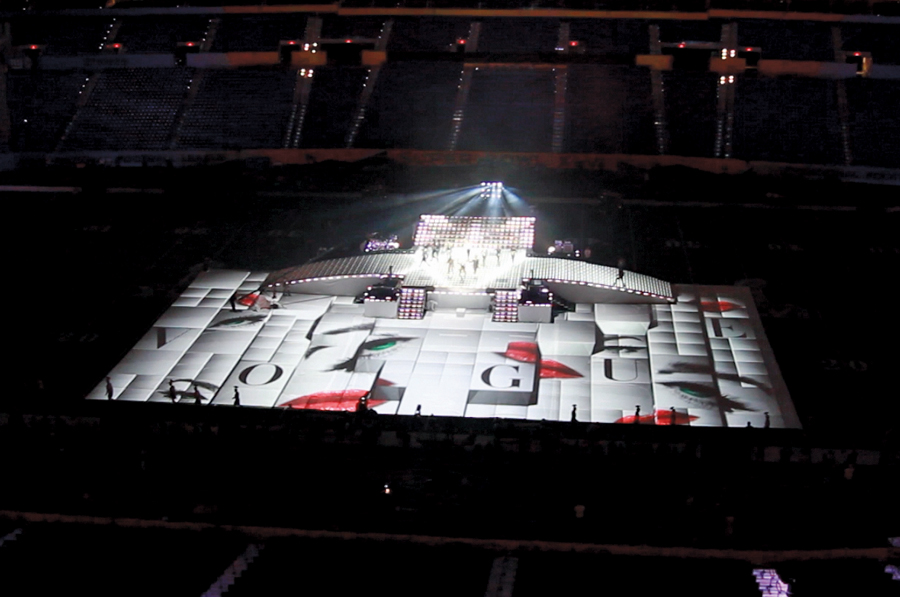The term “entertainment lighting” describes production lighting for theatres, films, television shows, concert tours, discotheques, exhibitions, awards ceremonies and more. Each year, and with each notable event, the entertainment lighting field and its countless special effects seem to further erupt. Today, it seems, no worthwhile events are without such smoke-and-mirror spectaculars.
Like her or not, Madonna put on a spectacular Superbowl halftime show, one that would fascinate anyone with even a mild understanding of Ohm’s law, because the electronics, lighting, electronics, projections and assembly were truly amazing. Most advanced, I think, was the projection system that created the animated, 3-D images that prefaced the stage area.
The Moment Factory’s (Montreal) team of 12 multimedia artists created the 3-D projections. This crew collaborated with Bruce Rodgers, the show’s production designer, and lighting designer Al Gurdon, a Cirque du Soleil team, plus Madonna herself, and dozens of other teams that designed and programmed the show
effects.
Interestingly, these participating lighting teams, although unheralded in the everyday world, are entertainment-industry famous for their stage and event lighting skills. They often work together on the same project. For example, Madonna’s halftime stage builder, All Access Staging & Productions’ (Los Angeles) resume also includes the Grammys, the Daytime Emmy Awards, the 2008 Democratic National Convention, the Michael Jackson Memorial and the MTV Video Music Awards.
Moment Factory and Tribe Inc.’s Bruce Rogers worked mutually on many of those projects. Rogers designed Madonna’s cross-shaped stage. The criterion: To present amazing – and unfailing — lighting dynamics, with seven minutes for assembly and disassemble (on and off field).
The stage comprised 58 numbered, arrayed and synchronized carts, each individually equipped with LED-lamped tiles, projection systems, spots, step and enclave lighting and other installed, electronic devices. Several contained hydraulic lifts, to elevate the entertainers during the show’s prime moments.
Advertisement
The actual stage installation consumed five minutes, not seven, and, get this — the install crew, some 400 bodies that carried gear, pushed carts or plugged in lamp assemblies — shared the space with the incoming and outgoing talent.
They must have had traffic cops.
The halftime lighting inventory comprised approximately 900 lights and light-related items – consoles, lamps, floods, fixtures, strobes, LED blocks, foggers, hazers, spotlights and flame devices.
All lighting was software driven and cued to trigger at the exact moments, once the show began.
Tribe, Inc. describes itself as a “…full service production design studio creating unique, collaborative, and highly specialized designs for the entertainment industry.” Its staff comprises designers, artists, writers, filmmakers, project managers and specialists. Bruce Rodgers, president, is an award-winning designer with more than 20 years in the field. His fans say his design influence has helped define the entertainment-lighting visuals we so often see today.
The show’s pyro work was conducted by Ron Smith of J.E.M F/X (Valencia, CA); Stage Rigging (Redwood City, CA) handled the rigging; Lighting was implemented by PRG Lighting Services (Armonk, NY) and Full Flood (Los Angeles); ATK AudioTek (Valencia, CA), Green Hippo (London) and Coolux (Agora Hills, CA) provided the playback system. The NFL handled technical specifications.
The stage area’s LED-based lighting modules – 442 to be exact – were Chroma-Q™ Studio Force™ color blocks, manufactured under license from Philips Color Kinetics (Andover, MA) by Spectrum Mfg. (Toronto). They’re available through A.C. Lighting, also of Toronto. The Studio Force series, which includes a multi-purpose lamp package, is for TV, film, touring, exhibitions, corporate events and theatre-lighting applications.
Advertisement
Moment Factory’s creative director was Sakchin Bessette; its producer was Johanna Marsal, and multimedia direction came through Pamela Rocks. Their challenge, along with Rogers, Gurdon and other shows specialists, was to produce fascinating content that fit the set – and satisfy Madonna.
Julie Armstrong-Boileau, Moment Factory’s spokesperson, said their part took approximately three months, from conception to integration. She also confirmed what I suspected when first viewing the event — the install crews blanked the field surrounding the stage with a fabric that enhanced the projected images’ color and sharpness.
Julie said their project’s most difficult challenge was producing 3-D images, because of the required rendering time required for such complex content. “We had to make sure everything was perfect, and completed on schedule,” she said. Further, last-minute changes required extra rendering hours.
The stadium size and scale allowed the Moment Factory team to expand its creativity (they usually work on indoor projects). Thus, in Indianapolis, they often projected directly on the football field during the design process. It made a great canvas, Julie said.
Writer Ellen Lampert-Greaux, for Livedesignonline.com, wrote, “The [Madonna halftime show] result was among the most technically challenging halftime-show designs on record, with the largest cast, the most lift effects, biggest projection and lighting rigs, the fastest installation and strike, the most extensive field projection — and the best creative casting and costuming coordination ever in Super Bowl history.”
Julie said the most fun part was working with Madonna. All participants commented on Madonna’s constant attention to show details.
Advertisement



 Tip Sheet1 week ago
Tip Sheet1 week ago
 Photo Gallery1 day ago
Photo Gallery1 day ago
 Ask Signs of the Times3 days ago
Ask Signs of the Times3 days ago
 Real Deal1 week ago
Real Deal1 week ago
 Benchmarks6 days ago
Benchmarks6 days ago
 Editor's Note2 weeks ago
Editor's Note2 weeks ago
 Women in Signs1 week ago
Women in Signs1 week ago
 Photo Gallery1 week ago
Photo Gallery1 week ago









